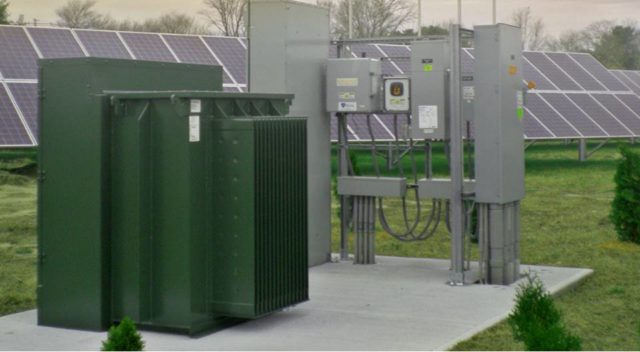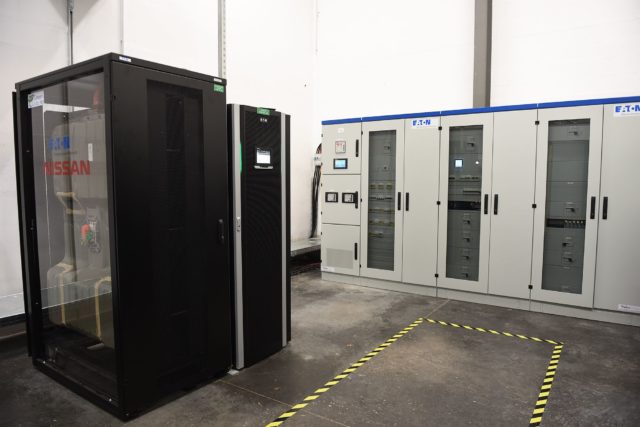>> Microgrids
> U.S.
– Energy Security Microgrid for Marine Corps Air Station
Black & Veatch (B&V) and Schneider Electric USA have entered into a joint venture to design and build the energy security microgrid at Marine Corps Air Station (MCAS) Miramar in San Diego.
More than 15,000 Marines, Navy sailors from the 3rd Marine Aircraft Wing, and their families live on the base. The scalable microgrid is initially being designed to provide emergency backup power at 12 kV to mission-critical facilities. In the future, the potential exists to meet all the MCAS Miramar’s power needs as well as manage electricity supply and demand during peak periods, according to a press release.
The microgrid will draw on renewable energy resources as well as diesel and natural gas for power generation as well as incorporate smart grid control systems and demand response capabilities. B&V and Schneider will provide a 7 MW diesel and natural gas power plant integrated with energy and microgrid control systems that comply with Department of Defense (DoD) security infrastructure and risk management requirements.
In turn, MCAS Miramar’s microgrid, will be integrated with a utility control system at Naval Base San Diego, which will be equipped with a redundant control system. Project completion is slated for July 2018.
The DoD plans to deploy 3 GW of renewable power capacity on military installations by 2025 as per an executive order from President Barack Obama.

– Stacking Service Streams Key to Success in First U.S. Municipal Solar-storage Microgrid
The Village of Minster, Ohio´s municipal power utility is first in the U.S. to serve as the anchor customer of a solar energy storage system, a 3 MWac solar energy array coupled to a 7 MW/3 MWh lithium-ion battery energy storage system, according to a news report.
Following the lead of Governor John Kasich, many of Ohio’s state legislators have opposed instituting incentives to spur emissions-free renewable energy investment and deployment. Minster’s town council, in contrast, has been enthusiastic about solar and renewable energy, seeing it as a means to reduce volatility of energy costs, contain energy price increases , and help improve the environment and quality of life.
Minster officials decided to team up with Half Moon Ventures, which in turn brought in S&C Electric, an international electric services provider, as a project partner.
The municipal utility will be paying $0.07/kWh for solar-generated electricity delivered via the microgrid and $0.095/kWh all-in with battery energy storage costs included. That’s the same as the average retail electricity rate it charges customers.
Added to that are savings of approximately $1 million on a budget of $7 million per year, which will help avoid raising customers’ rates, according to the news report.

– MIT Lincoln Lab Lays Out Microgrid Design Plan for Boston
Areas using microgrids had been the most resilient when Superstorm Sandy made its landfall in 2011. New York City took a $19 billion economic hit from that storm. Much of the bill went to repairing the city’s energy infrastructure, failure of which led to billions of dollars of losses that rippled through the city’s economy.
Boston’s taking the lessons learned to heart. Staff from MIT Lincoln Lab and Boston Redevelopment Authority (BRDA) teamed up and recently completed the Boston Community Energy Study, an investigation into a resilient power system design for the city, according to an MIT Lincoln Lab news report.
Determining where energy use in the city is highest was the first step in laying out a city-wide microgrid design. More specifically, the determination entailed identifying an ¨anchor building¨ that uses enough electricity to justify investing in a microgrid.
As MIT Lincoln Lab explains, identifying anchor buildings in neighborhoods around the city ¨makes an infrastructure investment palatable to the city and encourages local stakeholders to consider connecting to the microgrid.¨
More broadly speaking, Lincoln Lab Energy Systems Group member Eric Morgan notes that integrating microgrids into Boston’s energy infrastructure would convey numerous and varied benefits.
“First, microgrids can decouple from the larger utility grid and operate autonomously, making them more resilient to large weather events,” says Morgan. “Second, when electricity generation and consumption are co-located, as with many microgrids, there is an opportunity to utilize the waste heat (i.e., the byproduct of energy generation) within neighboring buildings for hot water, heating, or even cooling.”
The city-wide microgrid design team came up with 22 proposed microgrid sites. The team estimates Boston could realize $1 billion in financial and environmental savings over the next two decades by deploying theses sites.
– Coastal Massachusetts Town Looks for Solar-Diesel Microgrid Partners
The town of Gosnold, which encompasses the Elizabeth Islands near Cape Cod, has issued a request for proposals (RFP) to deliver, install, and commission a battery energy storage bank, microgrid controller, and power electronics to support the town’s solar-diesel microgrid.
>> Energy Storage
– New Mexico Senator to Propose Energy Storage Tax Credit Bill
New Mexico Senator Tom Heinrich will introduce an investment tax credit (ITC) for energy storage in the Senate next week, according to a news report. Modeled on the solar ITC, the proposed bill would offer businesses and households installing energy storage systems a 30% tax credit.
House Representative Mike Honda (D-CA) introduced a similar bill in the House in May. Heinrich proposed instituting a national energy storage mandate last year. The proposals failed to take hold, however.
The Senator believes his colleagues may be more supportive of an energy storage tax credit that, akin to the solar ITC, would begin to scale down in 2020.
“Given the parallels we’ve seen with adoption of solar technology,” says Heinrich, “I think the tax credit approach has the potential to help storage grow quickly while attracting bipartisan support.”
> International

– Recycled Nissan Leaf Batteries to Create Storage System for Normandy Data Center
The installation at Webaxys’ data center at the Saint Romain de Colbos Eco Park in Normandy, France, is the second project Nissan and U.S. energy and industrial engineering company Eaton have undertaken to design and build an industrial-scale, grid-connected energy storage system using recycled lithium-ion batteries from Nissan Leaf EVs.
In addition to giving Nissan Leaf lithium-ion batteries a second life, Webaxys’ system draws on renewable energy sources for electrical power, thereby minimizing its carbon and environmental footprints.
Data centers account for 1.5-2% of energy consumption worldwide, and that number is growing fast. Webaxys, encouraged by the Battery Energy Storage System (BESS) performance, intends to install similar systems in other regional data centers.
“This installation at Webaxys marks an important historical moment for data centers in their quest to become energy autonomous in the near future,” says Nissan Europe Director of Electric Vehicles Gareth Dunsmore. “By combining Nissan’s expertise in vehicle design and reliable battery technology with Eaton’s leadership in power quality and electronics, we hope to demonstrate that data center energy management can be stable, sustainable, and cost-efficient in the near future.”
>> Solar Power
> International
– UK Solar Power Output Hits New High
Solar energy systems met a record-high 23.9% of nationwide electricity demand in the UK on July 4, the third anniversary of Solar Independence Day, a news report highlights.
The Solar Trade Association (STA) marked the occasion by launching a new initiative for elevating operations and maintenance (O&M) standards for large rooftop and ground-mounted solar PV systems.
Almost 12 GW of rated solar power capacity has been installed across the UK to date. The rapid growth rate has persisted despite the national government scaling down its support, which industry participants say has been directly responsible for the loss of more than half the 35,000 total jobs in the renewable energy sector.
In addition to launching its solar O&M standards campaign, STA is promoting its ¨Solar Independence Plan for Britain,¨ which explains how the UK government can spur deployment of as much as 25 GW of solar power across the nation by 2020.
“The UK has successfully deployed almost 12GW of solar across the UK, providing nearly 25% during peak generation,” says STA chief executive Paul Barwell. “This [solar deployment] is what the country and the world needs to decarbonize the energy sector at the lowest price to the consumer. The Government’s adoption of the Fifth Carbon Budget is a good long-term signal in this regard.
“Solar Independence Day is about celebrating what a large group of small and medium-sized businesses can achieve in a short period of time. We now need just one more push from the government to help the solar sector reach its objective of zero subsidy by the early 2020s.”
